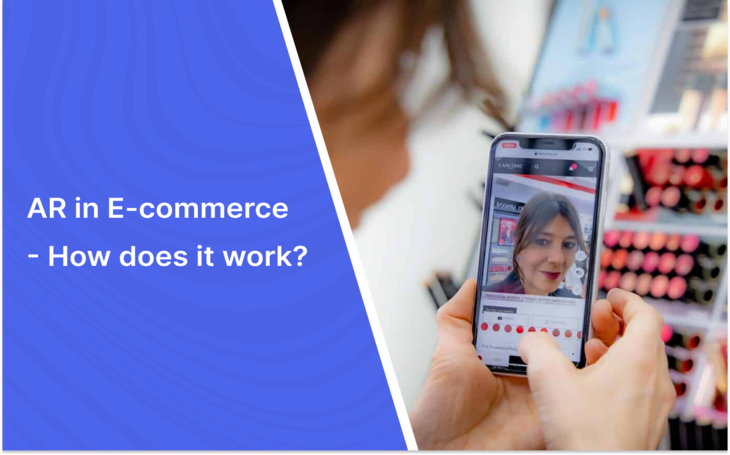
Augmented Reality or AR is an immersive technology that can blend real and virtual environments, offering users the best of both worlds. It has penetrated multiple businesses and industries. E-commerce is one of them. AR in e-commerce is helping customers make informed decisions as well as allowing companies to enhance customer experience.
Jennifer Liu, Google’s Director of Product Management, said “For many consumers, it’s the next best thing to actually having the product with them in their own home.”, in the importance of AR technology for e-commerce businesses.
Let’s look at how AR is helping e-commerce businesses to serve their customers better and boost revenues.
What Is AR?
AR is a technology that comes from the same immersive technology equation as Virtual Reality (VR). This technology extracts the digital elements and puts or superimposes them in the real environment, bringing virtual aspects into the real world.
These virtual and real elements coming together enhance the user experience of any app or platform. AR is used extensively in the online shopping experience as it allows users to try things on from the comforts of their homes or on the go and make a conscious decision. AR in businesses is a huge success.
In fact, 64% of consumers believe AR can benefit them in their shopping experience.
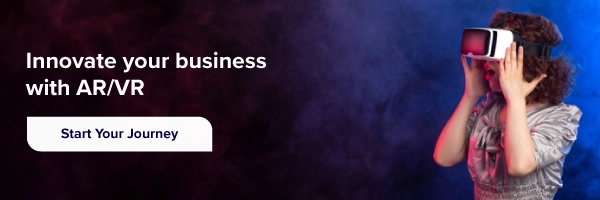
How Are E-Commerce Stores Using Augmented Reality?
With the use of augmented reality, e-commerce platforms are able to provide customers with an option to preview the product with just one click, sitting comfortably in their homes, on their own time.
AR in e-commerce helps the customer to choose the most suitable product the first time and businesses avoid the hassles of return and exchange deliveries.
In fact, 57% of customers said in a survey that they are more likely to spend on a brand if they are using AR.
L’Oreal, a global beauty brand, went through a digital transformation in the last decade and adopted the AR try-on technology in 2018 to offer the best beauty tech experience to its customer through AR and other services.
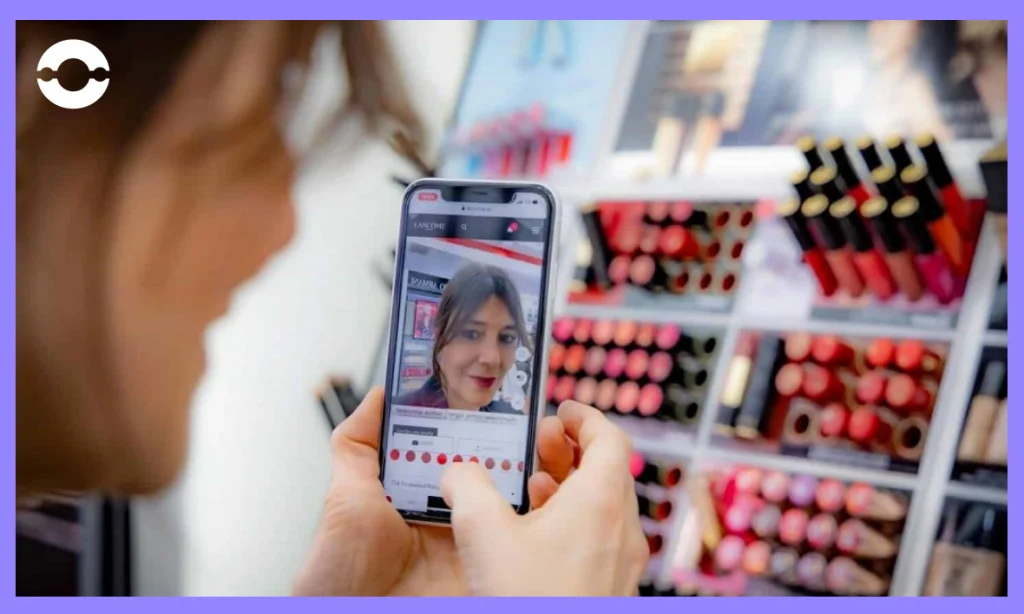
With more than 1 billion visits and an average of 7 minutes spent on its services, L’Oreal claims that the AR feature drove their online sales and multiplied conversion rates by 3 times.
In 2020, L’Oreal highlighted a ‘remarkable development’ for the brand in its annual reports, accounting for 27% of sales in 2019 on the brand’s own and retailer websites, reaching its peak in 2020 with e-commerce responsible for 34% of sales.
Therefore, brands have been using this technology to attract more customers, retain them and play big in the marketplace.
E-commerce platforms have been and are leveraging AR to offer the following:
1. Virtual ‘Try Before You Buy’ Solutions
Virtual try-on solutions help customers try on the products before investing in them. In fact, 43% of shoppers who use smartphones said that they expect all the beauty brands to use AR and 47% of shoppers said the same for automotive brands.
With AR, when a customer makes a purchase, he/she is more confident about the choice and feels more in the power of the money spent, and this also helps increase conversion rates for businesses.
At the same time, businesses do not have to spend a lot of time, effort, and money on exchanges and returns.
Sephora, a multi-brand beauty and skincare retailer, has an app with virtual artist, power, powered by AR technology. This app allows all beauty lovers and enthusiasts to try out cosmetics from multiple brands using advanced facial recognition software. The app also includes tutorials, tips, and different application ways for different products.
2. Preview Placement
Interior designing, furniture platforms, etc., all these e-commerce businesses are leveraging AR to give customers a preview placement option.
Does the cupboard seem too big for the available space? Is the wall painting too small for the wall? Is the chandelier of the right height for the room? These questions are generally going on in the minds of the customer seeking these home items and accessories.
With AR, customers can exercise the option of preview placement, and gives a fair, real-time idea of what the product would look like in the available space.
IKEA, a furniture retail giant, allows customers to virtually “place” IKEA products in their space via the app. This help users make more informed decision and investment.
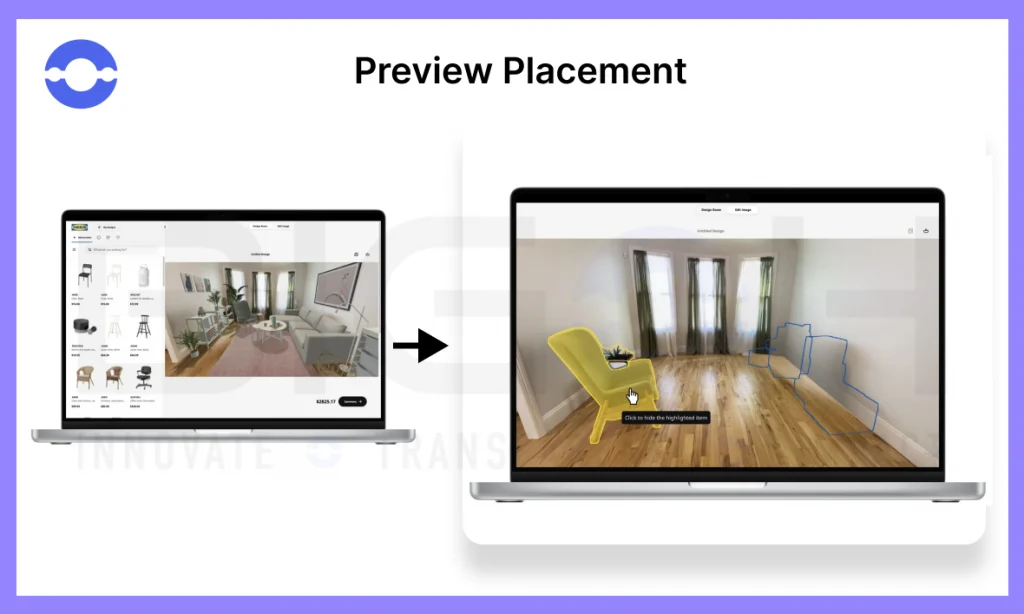
3. Interactive User Guides
With the use of AR in e-commerce, businesses are able to help customers engage more and get better insights into the products, both online and in-stores. These platforms are adding interactive user manuals or guides, instructional videos, and other types of immersive ways to tell the brand story and boost sales.
An interactive user guide responds to user actions. It offers on-page contextual support to users navigating through software, website or an app.
Additionally, as smartphones are taking over the world at a rapid pace, shoppers are coming to stores along with their own research capabilities. A report state that 34% of shoppers made use of smartphones to assist them with in-store shopping in 2021 – up from 28% in 2020.
Moreover, 85% of shoppers say that product information and pictures are important to them to decide which brand or retailer to buy from.
Owing to these evolving customer behaviors, AR is being adopted by an increasing number of online as well as offline stores today. With space constraints on the packaging, there’s not much information that is available about the product for customers to view and read. Hence, these AR-enabled interactive, instructional, and informative videos are adding to the shopping awareness and experience of the customers.
Jack Daniels, a famous liquor brand, built an AR activation. This offered customers the opportunity to take a virtual tour of the distillery and know more about the complete distillation process/experience by scanning the label and getting redirected to the company’s AR app, available for download on both Google Play Store and Apple App Store.
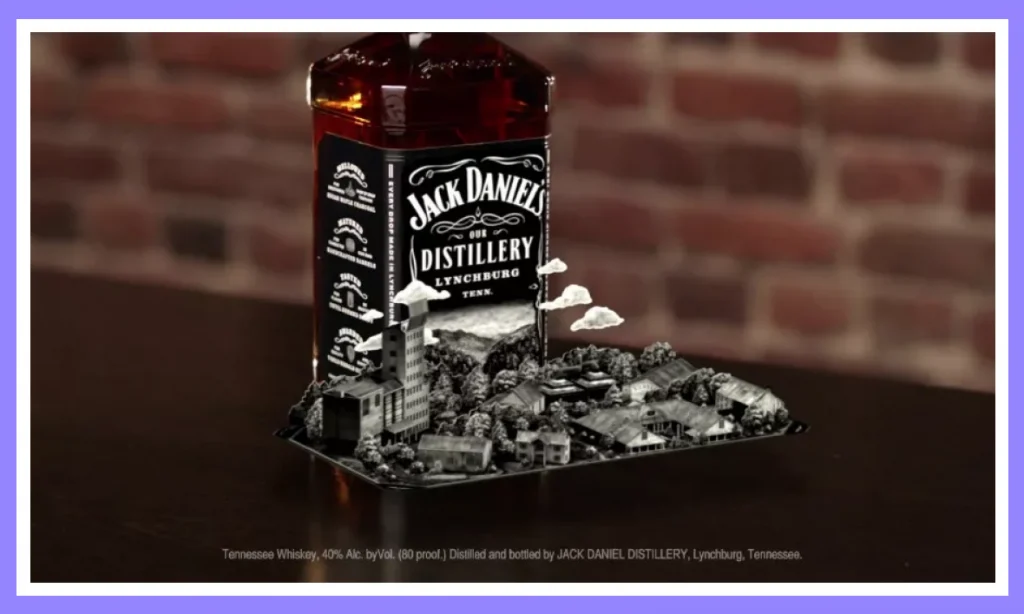
Additionally, customers can also learn more about the origins of the brand they are spending on, its journey from inception till now, and much more.
4. Marketing Strategies And Campaigns
With multiple social media filters and multiple generations hooked on to these social media apps, businesses got a chance to up their marketing game.
Using AR in e-commerce, businesses offered users to try on products or engage in fun games related to their products in order to explore and experiment with new products and services.
For example, Starbucks launched an Instagram filter called ‘Which Drink?’ in 2020. This digital marketing campaign, during fun times of using a social media app, helped users to find the perfect beverage for themselves. This was done by randomly selecting a Starbucks drink for them when the filter was activated.

The brand also encouraged customers to use the filter even within store locations. This would help them find inspiration and experiment with multiple, different products. This would in turn lead to higher sales and better, more positive in-store experiences.
In fact, in digital marketing campaigns, 67% of media planners and buyers want AR/VR ads. These social media filters and AR/VR marketing campaigns can help a brand stand out from the competition and engage customers in fun, fresh and quirky ways.
How AR Can Help Grow Your E-Commerce Store?
According to a PwC report, online shopping via mobile phone has increased to 45%, since the beginning of the pandemic.
Additionally, another Google report suggests that 66% of people are interested in using AR technology for help when shopping.
Therefore, AR technology enhances the customer experience and thus, is highly demanded by them for better product and service clarity and details. This helps them make better decisions.
At the same time, it’s highly beneficial for businesses too. It leads to higher conversion rates, among other things.
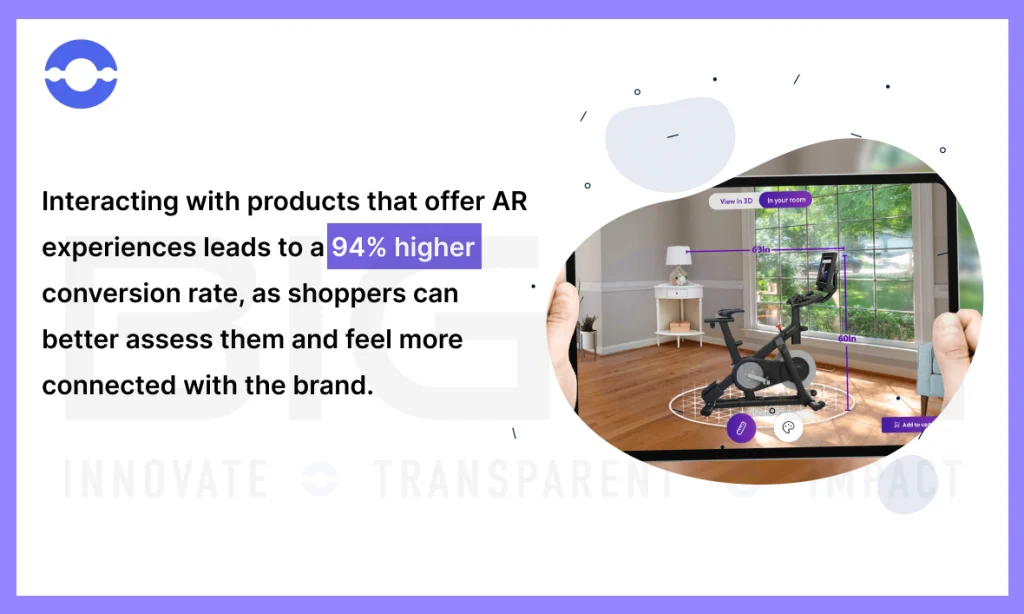
Let’s look at some benefits that AR technology offers e-commerce businesses and shoppers:
1. Enhanced Customer Engagement And Relationships
AR is an immersive technology. It interacts with the user, leaving a long-lasting impression and image of the product and service viewed using the technology. This enhances customer engagement and brands are able to build deeper, longer connections with the customers. At the same time, the user gets an immersive shopping experience.
If even the customer does not buy the product or service on the first go, the chances of him/her revesting the product/service page, or app are higher due to the visually informative and descriptive data the customer engaged with. Some brands also give their backstory with such visuals, which help them initiate a better interaction or relationship with the customer.
In fact, research highlights that retailers who have incorporated AR technology during the pandemic are experiencing a 19% increase in customer engagement.
2. Reduced Return Rates
With increased online shopping, one of the most prominent issues faced by e-commerce businesses are higher return rates. A BBC article highlighted that 49% of UK online shoppers had sent something back in the past year, rising to 60% for those aged 16-34.
This could be due to multiple reasons, but the most common ones are that the color didn’t suit or match or the product was not as described. This is where e-commerce platforms could incorporate AR technology and help customers make a more confident and informed purchase.
It offers 3D visuals, virtual try-on options, and product demos, facilitating more conscious and informed decisions. This brings down the return rates as customers have a fair idea of what they have ordered. AR facilitates informed purchases.
3. Higher Conversion Rates
Products that are marketed using AR/VR technology have higher chances of being noticed, engaged with, and invested in. A Deloitte report highlighted that 40% of shoppers would even pay more for a product if they were able to test it through AR technology.
Consumers get an idea of the product description, features, and functionalities, through interactive informational videos or product demos. This gives them a better understanding of the product/service and they feel more confident about their choice.
In fact, Shopify has claimed that products advertised in eCommerce with VR/AR content saw 94% higher conversion rates than products without that content.
4. Stand Out From The Competition
E-commerce businesses that are using AR technology offer their customers an immersive, engaging, and comprehensive experience. The customers feel more confident and informed while shopping with such brands. They feel in control of their decision and money and hence, return to shop more with these brands.
This is all because AR technology also saves them the time and efforts made to perhaps return or exchange the product. It facilitates an effortless and immersive shopping experience and customers choose them over other brands, again and again.
Conclusion
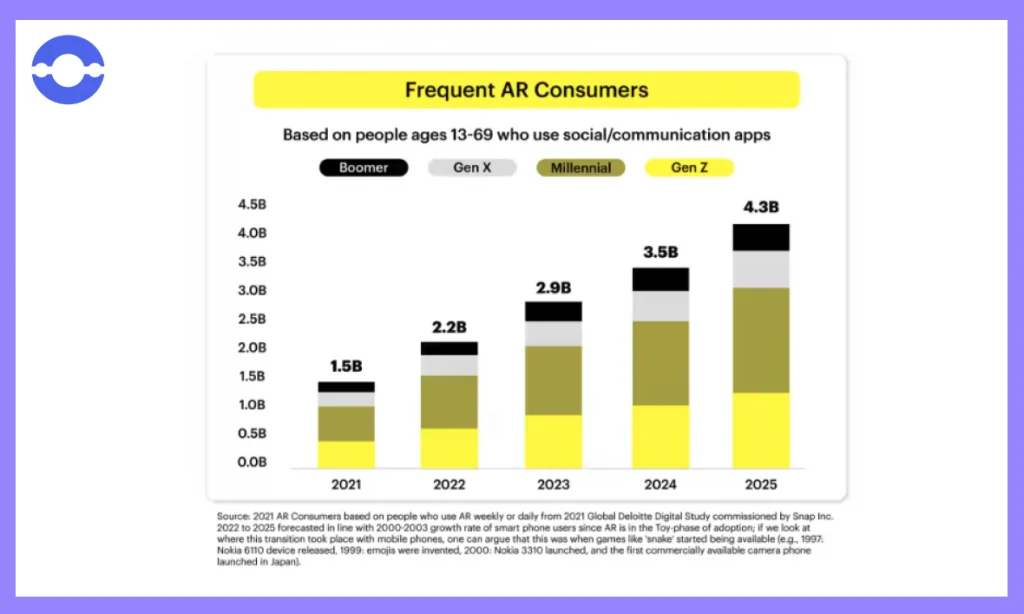
With about 75% of the world’s population expected to be regular AR users by 2025, businesses should adopt this revolutionary technology to enhance shopping experiences without any delay.
It has something for both shoppers and businesses. While shoppers feel more confident about their purchase, thanks to immersive and more informed experiences, businesses are able to reduce return rates and boost conversion rates.
A delighted and informed shopper always adds to the business, either monetarily or as a marketer, doing mouth publicity. Either way, a business gains, sometimes in the short term, other times in the longer runs.
How can BigOhTech help?
We understand the rising importance of AR in e-commerce and thus we offer the most high-quality and modern AR VR App Development services.
As an AR/VR development company, BigOh provides modern and comprehensive tools & platforms such as Unity, AR Core, ARKit, Vuforia, and Wikitude.
Our certified, dedicated development team including the AR/VR experts is adept at designing, developing, and deploying unique and engaging AR & VR apps that drive digital engagement and growth.
Don’t delay immersing and engaging your customers through AR technology and benefit from the competitive edge.
Get in touch with us today and climb the ladder of success!
FAQs
Yes, as per a report, around 43.7 million people in the U.S. would use social network AR at least once a month in 2020.
As per a social media giant, Snapchat, 65% of AR consumers worldwide, belonging to different age groups use AR to have fun, with the majority discovering AR through social / communications apps.
Moreover, more than 90% of American shoppers currently use or would consider using AR for shopping. Globally too, a greater number of people are using AR for their shopping experience and on social media.
Augmented Reality and Virtual Reality have origins in the immersive technology equation; However, AR is the superior version of VR. Thus, AR vs VR is a frequently asked question on the internet today.
While AR augments the real-world environment, VR creates entirely immersive virtual environments.




